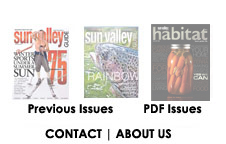Valley Gets Its Goat On
Natural weed-eaters take to the bike path
by Tony Evans
photos by David N. Seelig
Ray Holes and his band of 7,000 billies and nannies have made it their mission to rid five Western states of unwanted weed infestations. The merry flock munches its way through brush around homes in California to reduce fire danger, chomps through orchard undergrowth in Oregon so foxes and hawks can better keep the vole population in check and, this past summer, spent some quality time addressing the Wood River Valley's knapweed problem.
Ambling northward along the Wood River Valley's bike path from Bellevue to Ketchum, about 700 of the Boer breed goats devoured hundreds of acres of knapweed, clearing the invasive species long enough for native grasses to take hold once again. This non-native weed is so prolific that it crowds out native plants, reducing forage for wild and domestic animals.
As they moved through the valley, the four-legged weed-eaters also won the hearts of the community. "When I see the goats briskly grazing noxious weeds on the side of our community bike path, I gain a wonderful sense of joy and relief," said Narda Pitkethly in a letter to the Idaho Mountain Express. "We're experiencing progress instead of poison. This may not be an end-all solution, but it shows first-rate intentions."
The brainchild of Brian Ross and Susan Reinstein, founders of Pesticide Action Network of Blaine County (a citizens group advocating alternatives to chemical pesticides), bringing goat mowers to the Wood River Valley is part of an ongoing plan to implement alternative weed management policies. The goal is the eventual elimination of toxic herbicides and pesticides.
Holes, whose company Prescriptive Livestock Services is based in Grangeville, Idaho, brought his flock to town in June 2011 to begin six weeks of targeted grazing as part of a three-year pilot program.
Goats have specific tastes that make them natural weed-eaters, and they eat many things that other creatures avoid, including knapweed. While they will, if left to their own devices, eat everything—good plants too—they prefer knapweed to grasses, which have less protein content, so they eat the bad first. "They have huge livers so they can clean up a lot of toxins in weeds, like alkaloids and tannins, things that we consider poisons," Holes said. In addition, enzymes in a goat's gut serve to break down more than 99 percent of knapweed seeds, resulting in droppings that don't repopulate the weed.
Timing is everything when it comes to fighting knapweed. "It's important to get the plant when it's in bloom, before the seed hardens," Holes said. "Eventually grasses and other vegetation can take over. It takes less time after a few years, but the second year there can be even more weeds because the plants are working harder to propagate."
The goat project is more expensive than spraying the bike path with weed-killer: $45,000 compared to $10,000 for spraying. |
Last year the difference was covered by a $33,000 grant from PAN BC founders Ross and Reinstein. "We hope the cost will come down with time," said Jim Keating, executive director of the Blaine Country Recreation District, which manages the bike path for the community. The expense should be less in future years as the goats are needed for shorter periods of time.
A project along the Weiser River 75 miles west of Boise supports this theory. Holes has had herds fighting leafy spurge along 43 miles of the river for 10 years. The Weiser project covers about 12,000 acres of riverfront and side canyons, including places where it is difficult to operate equipment.
Bonnie Davis, the project's coordinator, has seen the goats make a difference. "There has been great success in some areas—in others areas it just suppresses the weeds. But from an environmental and economic perspective it was our only option," Davis said. "Spraying is cost prohibitive, up to $400 per acre, and the goats are going places a human being wouldn't dare. They are moving through quicker each year. If we skip a year, there would be a sea of yellow leafy spurge again."
The goats haven't been greeted with universal praise in the Wood River Valley. "Some folks don't like that there are animals out there, but we are excited that the bike path didn't need to be sprayed this year," Kathryn Goldman, campaign director for PAN BC, said.
Critics were annoyed that portions of the bike path were littered with raisin-sized goat droppings. Other areas were chewed down to the dirt, apparently from leaving the hungry goats in one area for too long. Some Hailey residents complained that just north of Myrtle Street, the ground was "moonscaped." Keating admits that this is a learning process, and yes, they did make some mistakes. "They will eat everything in an area eventually, if you let them," Holes said.
The goats are not a permanent fix for Blaine County's knapweed problem, but continued cooperative efforts between public land managers and private landowners may be the best hope, and goats will likely be a part of the solution. "Blaine County's knapweed explosion is only being kept at bay. We are not winning the war by a long shot," said Mike Turzian, owner of Sun Valley Garden Center, who oversaw the goats on the Warm Springs property of one of his clients. He believes the goats could become an important addition to chemical spraying to eradicate the weed, but not a replacement.
The symbiotic nature of goat-based weed control combined with the lack of harmful health impacts on the local community and wildlife is hard to argue against. However, the key to success in winning the weed war is cooperation. If public agencies and private landowners don't work together to eradicate invasive weeds, the effort could be futile. "The good thing about the goat is that it doesn't care whose property it's on," Turzian said. "The bad thing about knapweed is it doesn't care either." |



